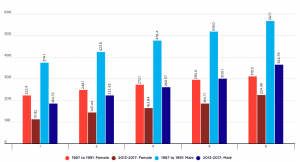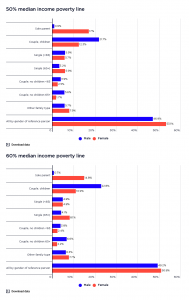This graph shows where people in different types of families are placed in the household income rankings. Single people are much more likely to be found in the lowest 20% income group – including 42% of single people without children and 36% of sole parents. This is despite the fact that when people are divided into income groups, their household incomes are already adjusted to take account of family size (that is, the incomes of larger families are adjusted downwards – or ‘equivalised’ – to reflect their need for more income to attain the same living standard).
Of all sole parents, 63% are in the lowest 40% by income. This reflects their lower rates of employment and greaterc aring responsibilities, and the relatively low levels of social security payments. According to the Australian Bureau of Statistics, 51% of sole parents are employed compared with 73% of parents in partnered families with children. In contrast, 26% of couples without children are found in the highest 20% income group. It is likely that this is due to the higher earnings and lower financial needs (captured by the equivalence adjustment referred to above) of younger, double-income childless couples and older workers whose children have left home.




